Two-Day Training Content
If you teach this introductory material as part of a two-day training, you should be able to perform all the activities noted below in 60–70 minutes. Components to include in this section for a two-day training include:
- Introductions of trainers and participants: 10 minutes
- Teamwork exercise: 12 minutes
- Introduction of learning objectives: 1 minute
- Overview of the course and materials: 5 minutes
- Patient story video and reactions: 10 minutes
- Barriers to team performance: 2 minutes
- Rationale for teamwork training: 4 minutes
- TeamSTEPPS framework: 5 minutes
- Characteristics of high-performing teams: 3 minutes
- Evidence of TeamSTEPPS's value: 3 minutes
- Applying TeamSTEPPS exercise: 5 minutes
Teaching Objectives
Specific objectives for teaching the introduction section include:
- Describe the TeamSTEPPS 3.0 training course.
- Describe the impact of errors and why they occur.
- Describe the TeamSTEPPS 3.0 framework.
- State the outcomes of the TeamSTEPPS 3.0 framework.
Teaching Process
Introductions of Trainers and Participants
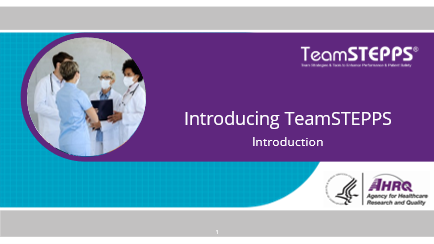
Referring to Slide 1, "Introducing TeamSTEPPS," welcome your class and express your appreciation for the investment they and their units or organizations are making in allowing them time to participate in this TeamSTEPPS training.
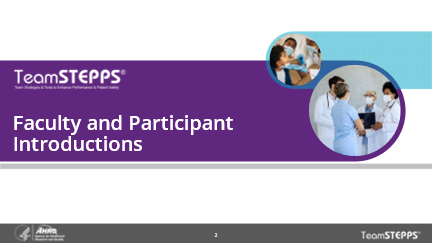
As you display Slide 2, "Faculty and Participant Introductions," you'll want to begin to achieve important relationship goals (i.e., relationships characterized by mutual respect, enjoyment, and transparency; creating connections with others in the training; and fostering relationships with patients and family caregivers). To start this process, have each faculty member and patient/family caregiver representative supporting the training share their name, what they do in the organization, and why they're excited to help participants learn TeamSTEPPS. You (the facilitator) may need to coach faculty to keep their introductions short and to show their commitment to helping participants learn TeamSTEPPS.
Next, ask each participant to share their name, what they do in the organization, and why they're excited to learn about TeamSTEPPS 3.0. You may want to prime the first participant you call on to set a pattern for other introductions to follow, to show that it is possible and desirable to share this information in a minute or less.
If you have a large class or limited time, you may want to have each table introduce themselves to each other or have a single person representing a team introduce their group. If the training is virtual, you can have some or all of the participants type their introductions into your platform's chat feature. If possible, review the backgrounds of participants based on registration information to adapt your examples to reflect their clinical contexts and teamwork challenges.
Teamwork Exercise
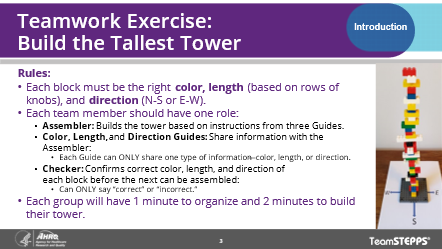
If time allows, use Slide 3, "Teamwork Exercise: Build the Tallest Tower," to start the course with a teamwork exercise that demonstrates that teamwork isn't always easy and that working to improve it can bring satisfaction. While many initial exercises are used, this exercise was created to support virtual trainings that do not permit in-person contact required for paper chain or other TeamSTEPPS exercises. Full instructions on how to prepare for and lead this exercise are available here.
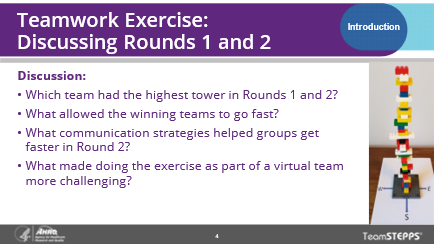
Using Slide 4, "Teamwork Exercise: Discussing Rounds 1 and 2," lead a discussion of the groups' experiences building their towers. If TeamSTEPPS tools are mentioned, or described without using their names, take this opportunity to acknowledge them and to indicate you’ll discuss them in the training that follows.

For Slide 5, "Teamwork Exercise: Conclusions," mention general conclusions from the exercise. Note that the trainees will do a variation of this exercise again later in the training.
Introduction of Learning Objectives
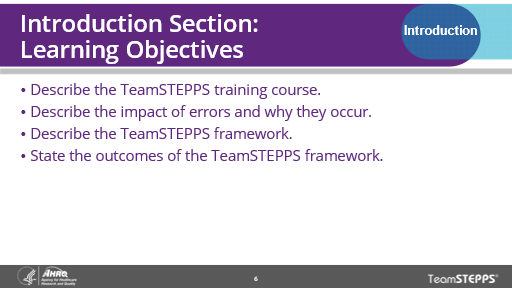
Review Slide 6, "Introduction Section: Learning Objectives"; save time by displaying the slide without orally reviewing each objective. Stress the broad goal of acquiring insights and tools that will enable the participants to enhance mutual support within their teams. Objectives include:
- Describe the TeamSTEPPS training course.
- Describe the impact of errors and why they occur.
- Describe the TeamSTEPPS framework.
- State the outcomes of the TeamSTEPPS framework.
Then note that these objectives will only be achieved by fully engaging with the material and other class members. You may want to explain that some concepts will be taught using exercises, case studies, or other nondidactic approaches and that explanations of all concepts and tools are easily accessible in the TeamSTEPPS Pocket Guide and on the TeamSTEPPS 3.0 website.
Overview of the Course and Materials
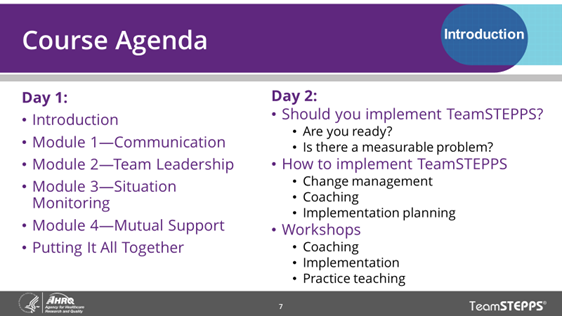
Use Slide 7, "Course Agenda," to review the general structure of the course and what will be covered on days 1 and 2. You may want to adjust this slide to reflect times for planned breaks and lunch, but it's also important to note that some discussions may be shorter or longer than planned.
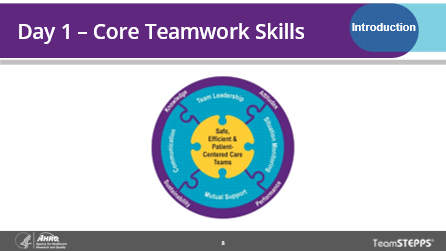
Using Slide 8, "Day 1 – Core Teamwork Skills," explain that the focus is on four teamwork skills, including:
- Module 1: Communication—Provides tools and strategies for communicating effectively through standardized information exchange strategies such as SBAR, check-back, call-out, and handoff.
- Module 2: Team Leadership—Defines a team and its members, including patients and their families; describes characteristics of high-performing teams; and addresses how to lead teams effectively using tools such as briefs, huddles, and debriefs.
- Module 3: Situation Monitoring—Describes the importance of team members gaining or maintaining an accurate understanding of the situation in which the team is functioning; discusses outcomes of situation monitoring, including a shared mental model among team members.
- Module 4: Mutual Support—Describes approaches to providing mutual support, or "backup behavior," that allows teams to become self-correcting, distribute workload effectively, provide effective feedback, and manage conflict.
Day 1 ends with a discussion of how the tools collectively can lead to high-performing teams and safer, more-effective patient care.
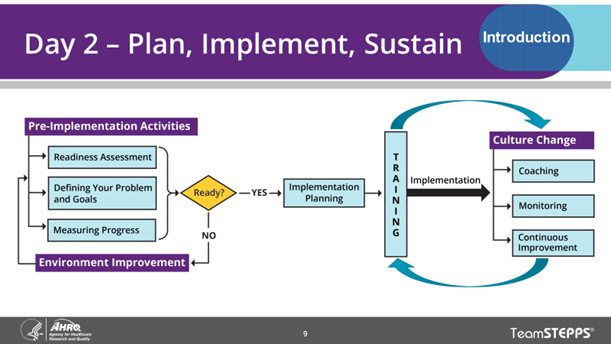
Using Slide 9, "Day 2 – Plan, Implement, Sustain," explain that day 2 of the course will focus on topics related to implementing and sustaining TeamSTEPPS. These include:
- Change Management: Provides information about organizational change through Kotter's Eight Steps of Change.
- Coaching: Explains coaching and role of a TeamSTEPPS coach; lists skills of effective coaches. Describes how to coach and the role of coaching in implementing TeamSTEPPS.
- Measurement: Provides information about evaluating the success of TeamSTEPPS implementation, including available assessment tools and resources.
- Implementation Workshop: Serves as a capstone to the course by allowing you and your team members to think through your implementation plans and strategies.
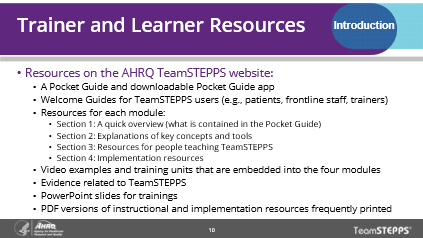
Using Slide 10, "Trainer and Learner Resources," explain that all TeamSTEPPS resources have been consolidated and optimized for online access and use. The website includes:
- A Pocket Guide and downloadable Pocket Guide app that provide quick summaries of key TeamSTEPPS concepts and tools. The app is being updated to match the new TeamSTEPPS 3.0 curriculum. A new version of the app will be available in fall 2023.
- Welcome Guides focused on diverse types of TeamSTEPPS users, such as patients and family caregivers, frontline staff, and trainers.
- Resources related to each of the four modules that are grouped into:
- Section 1: A quick overview (what is contained in the Pocket Guide).
- Section 2: Explanations of key concepts and tools, including examples and materials relevant to different care settings and types of teams.
- Section 3: Resources for people teaching TeamSTEPPS to others.
- Section 4: Implementation resources that will be covered on day 2 of the training.
- AHRQ video examples and video simulation training units with accompanying facilitator guides that are referenced in the four modules.
- A section on evidence related to TeamSTEPPS and information on where emerging evidence is shared.
- PowerPoint slides trainers can use or adapt, as well as some instructional and implementation resources included in PDF files for use as hard copies.
Patient Story Video and Reactions
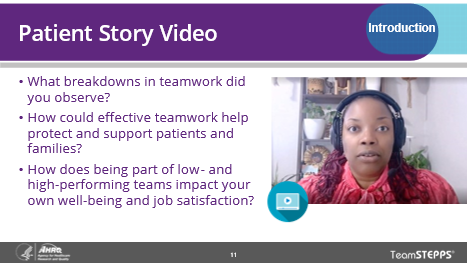
Using Slide 11, "Patient Story Video," play the story of Nikki or use one of the other patient story videos (Greg's story or Tara's story) on the TeamSTEPPS website; see the description of patient videos in section 2. Note that TeamSTEPPS exists to make patient care safe in every care setting and for every patient. Beginning the training with a patient story will help keep the patient central to your training.
You may want to have a patient or family caregiver who is functioning as one of the instructors share their story or have a patient or family caregiver attend to share their story. Because many trainings are now conducted virtually and include virtual instructors, including patients is easier than it has been in the past.
Once participants have listened to a story, either in small groups or as a class, ask them to discuss:
- What breakdowns in teamwork occurred in the story that could have been avoided?
- How could effective teamwork help protect and support patients and families?
- If participant responses indicate a skill, tool, or strategy taught in the course but participants use different terminology, rephrase the response back to them using the TeamSTEPPS terminology.
- If any of the participants answer negatively, focus the discussion on improvement opportunities.
- How does being part of low- and high-performing teams affect your own well-being and job satisfaction?
Barriers to Team Performance
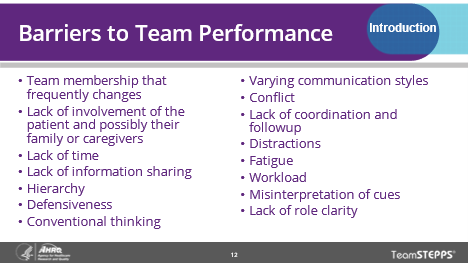
Before displaying Slide 12, "Barriers to Team Performance," ask training participants to identify barriers to effective team performance that may lead to patient harm. Once some have been identified, you can display the slide, which captures barriers such as:
- Frequent changes in team membership.
- Lack of attention to the central role of the patient and possibly their family or caregivers.
- Lack of time.
- Lack of information sharing.
- Hierarchy.
- Defensiveness.
- Conventional thinking.
- Varying communication styles.
- Conflict.
- Lack of coordination and followup.
- Distractions.
- Fatigue.
- Workload.
- Misinterpretation of cues.
- Lack of role clarity.
Note that the many barriers to effective teamwork make it important to train team members so they can work together effectively. Explain that when TeamSTEPPS was created, the patient safety movement was in its infancy and the groundbreaking Institute of Medicine (now National Academy of Medicine) report To Err Is Human had recently been released. Today, TeamSTEPPS is part of the ongoing patient safety movement and the training builds on lessons and research about the role teams play in preserving patient safety. Note that some key research is summarized on the AHRQ TeamSTEPPS website and that you’ll introduce other key findings throughout the training.
Rationale for Teamwork Training
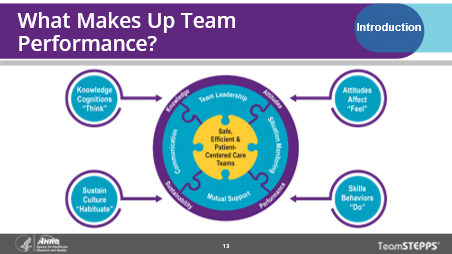
Using Slide 13, "What Makes Up Team Performance?," explain that TeamSTEPPS is built on an evidence-based framework composed of four teachable-learnable skills: communication, team leadership, situation monitoring, and mutual support. Sustainable knowledge, attitudes, and behaviors are foundational to each of these four skills. All are vital to ensuring safe, effective, and patient-centered care. While each skill has direct value, it also contributes to the effective use of the other skills, making every skill mutually reinforcing.
TeamSTEPPS Framework
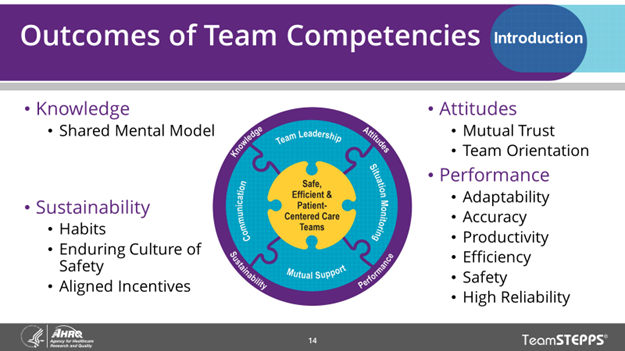
Use Slide 14, "Outcomes of Team Competencies," to review the four outcomes:
- Knowledge: Ask participants to give an example of a time when different knowledge held by different team members led to a major misunderstanding (e.g., misdiagnosis due to different team members knowing different diagnostic test results but not putting the information together to get the full story). Use the participants’ examples to illustrate that teams whose members have strong communication, leadership, situation monitoring, and mutual support capabilities yield important team outcomes. By sharing with the team, they achieve awareness about what is going on and progress toward their goal. Team members will also be familiar with the roles and responsibilities of their teammates.
- Attitudes: Ask the participants for an example of a team that had a shared positive attitude toward working with each other. Use the example to reinforce the value of working in teams in which the members have good communication, leadership, situation monitoring, and mutual support skills. Note that these team members are more likely to have a positive experience and that we all want to enjoy working in our teams and being able to trust our teammates.
- Performance: Explain that improved knowledge and attitudes will lead to improved performance. Team members will be able to adapt to changes in the care plan and will know when and how to back each other up. They will also be more efficient in providing care; the team will have a plan, and team members will know who is supposed to do what and how they are supposed to do it. The team also will be safer, allowing members to more readily identify and correct errors if they occur.
- Sustainability: Explain that having a strong safety culture, aligning incentives, and maintaining and reinforcing teamwork knowledge, attitudes, and performance over time will help sustain the practices despite staff turnover, competing priorities, adversity (e.g., pandemics), and complacency.
Acknowledge that effective teamwork cannot compensate for inadequate clinical or technical proficiency, chronic major staff shortages, or an overall organizational culture that does not recognize the importance of patient safety. But it can help individuals and teams cope with these challenges more effectively than they could otherwise.
Characteristics of High-Performing Teams
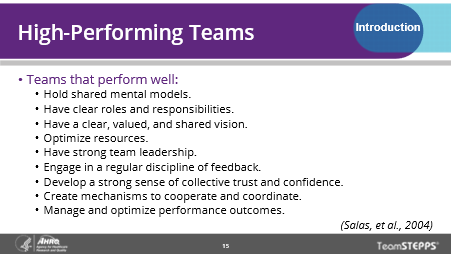
Before you display Slide 15, "High-Performing Teams," give each small group of participants two minutes to brainstorm a list of characteristics of high-performing teams. Then show them the slide. See which group got the most of these and whether they identified any other traits not listed on the slide. You may choose to emphasize one or two traits you think are especially vital. Note: participants will stay more engaged if you allow them to generate the list instead of describing it yourself.
If you have patients or family caregivers in your training, as trainers, storytellers, or participants, ask them to add their perspective on what constitutes high performance. And if you have trainees participating remotely or who regularly work as part of virtual teams, you may want to ask them to comment on what specific characteristics are particularly important to achieve high performance when the team’s interactions are virtual.
Evidence of TeamSTEPPS's Value
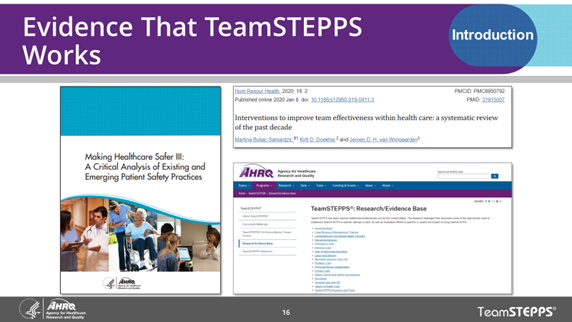
After you briefly display Slide 16, "Evidence That TeamSTEPPS Works," if you have internet access, display the TeamSTEPPS web page featuring the evidence base for TeamSTEPPS, and let the participants see the dozens of relevant articles describing its impact in multiple clinical settings. You also may want to call attention to these three reviews, which include a chapter devoted to teamwork in an AHRQ assessment of patient safety practices and systematic reviews published by Costar and Hall and Buljac-Samardzic, Doekhie, and van Wijngaarden in 2020.
You may also want to note that you can do a good job teaching TeamSTEPPS but not have positive impact. Achieving positive results requires effective implementation and a sustained commitment to a culture of safety.
Applying TeamSTEPPS Exercise
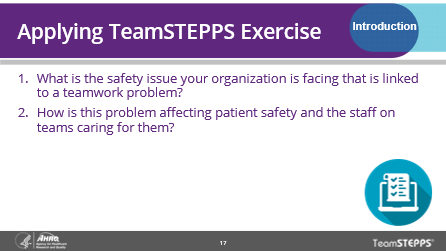
If you have intact teams in your training with short-term implementation plans, you may want to use Slide 17, "Applying TeamSTEPPS Exercise," to guide small-group discussions about their plans. Otherwise, you can omit this slide and its discussion.



